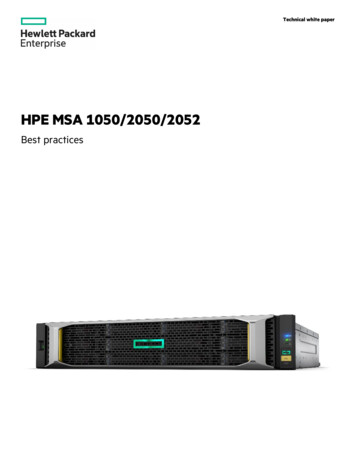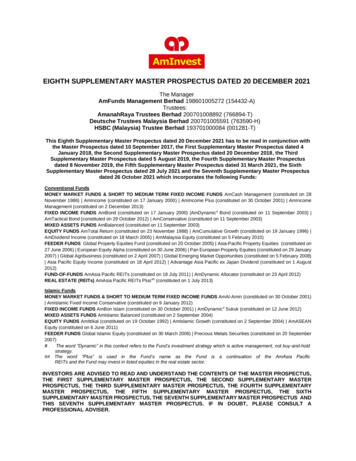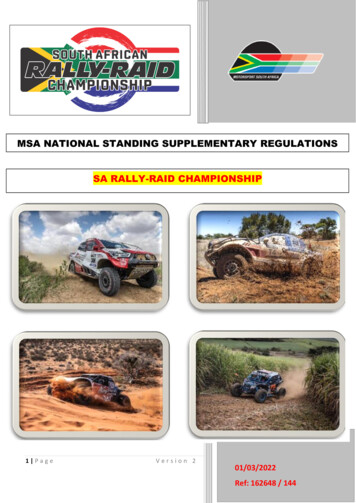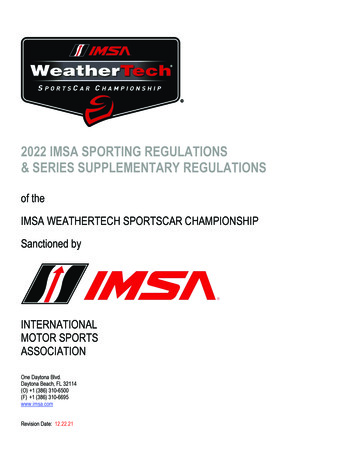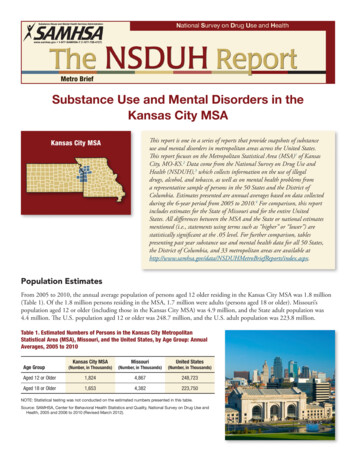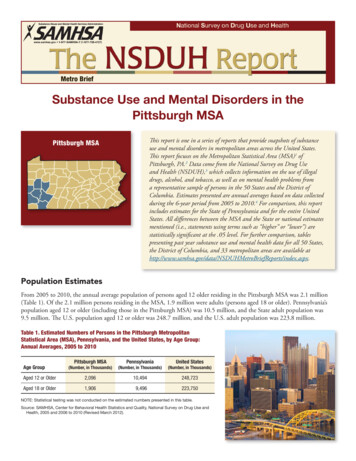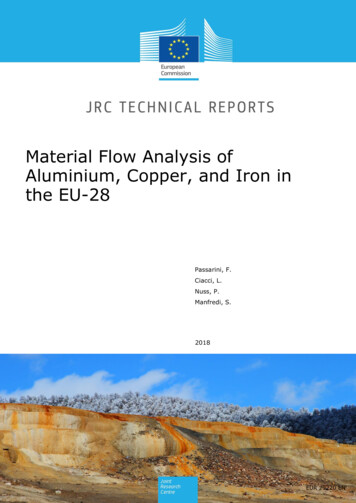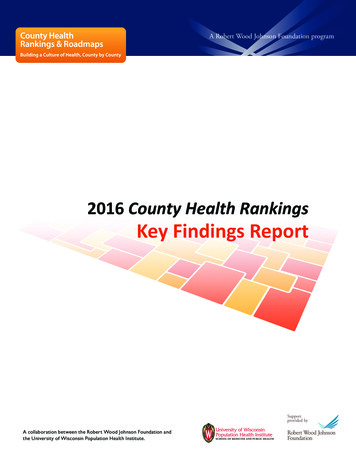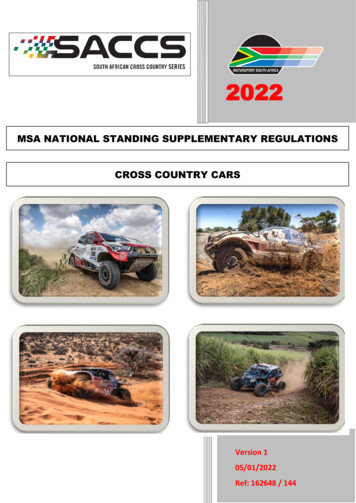
Transcription
2022MSA NATIONAL STANDING SUPPLEMENTARY REGULATIONSCROSS COUNTRY CARSVersion 105/01/2022Ref: 162648 / 144
REGULATIONS APPLICABLE TO CROSS COUNTRY CARRACING PART 1: APPLICABLE TO ALL EVENTSREVIEW AND AMENDMENTSAmendments and updates to the rules will be recorded in the Amendment Record, detailing the updatedversion, date of approval of the amendment and a short summary of the amendment.Modified SSR / ART2 Pa geDateapplicantcableDate ofPublication2022SACCS SSR’sClarifications05/01/2022
CONTENTS:SSR 300SSR 301SSR 302SSR 303SSR 304SSR 305SSR 306SSR 307SSR 308SSR 309SSR 310SSR 311SSR 312SSR 313SSR 314SSR 315SSR 316SSR 317SSR 318SSR 319SSR 320PART 23 Pa gePAGE:ELIGIBILITY OF COMPETITORSELIGIBILITY OF VEHICLESROUTE MARKINGROUTEROAD BOOKSROUTE DIRECTION AND DEVIATIONCONTROLSCLASSIFICATION AND TIME BARSDECONTROL SECTIONS AND DISTRICT ROADSROAD / RAILWAY CROSSINGSPRE- AND POST-RACE PADDOCK AND PARC FERMÉSERVICE CREW / OUTSIDE ASSISTANCEPRE-RACE PRACTISING AND RACE AERIAL OBSERVATIONYELLOW / WHITE LIGHTSTARTING ORDEROVERTAKING / BUMPINGREFUELACCIDENTS / USE OF MEDICAL WARNING BOARDS / INCIDENTS /RETIREMENTS / MISDEMEANOURSPENALTIESTEAM AWARDSCHAMPIONSHIP SCORINGCROSS COUNTRY CAR RACING PART 2CLASSIFICATION AND VEHICLE SPECIFICATIONS2022SACCS 5/01/2022
REGULATIONS APPLICABLE TO CROSS COUNTRY CAR RACINGPART 1: APPLICABLE TO ALL EVENTS1.1General: Wherever reference is made to the President of the SA Cross Country Series (SACCS), it may also include theCEO of SACCS and vice versa.1.2OFFICIAL NOTICES AND BULLETINSRefer GCR 17, 67, 70 b) [iii], [v], [vi], [viii], 88, 99 and 100300. ELIGIBILITY OF COMPETITORSNo competitor shall be permitted to start and compete in an event unless he/she has satisfied the officials concerned thatall the following are in order:[i]All Entrants, Drivers, second Drivers, Navigators and second Navigators must hold a current MSA Competitionlicence valid for the event. These licences must be presented at documentation.[ii]To obtain a National Competition Licence, competitors will have to have competed in and be classified as afinisher in a minimum of two (2) Regional Cross Country Racing events and have had their licence signed by theClerk of the Course. A National licence may be issued without the above qualifications if the competitor hascompeted at National level in other Motorsport disciplines and it has been approved by the CEO of SACCS.[iii] Where the entrant of a vehicle is not a member of the vehicle’s crew, an Entrant’s licence must be obtained fromMSA, prior to the submission of an entry form. Failing this, the entrant’s name will not be published in anydocumentation for the event.[iv] Competitors aged 14 to 16 years may only obtain a competition licence endorsed for Navigational purposes.Competitors aged 17 and older in possession of a learner’s or driver’s licence may be issued with a competitionlicence permitting the competitor to drive a vehicle failing which licences must be endorsed for Navigation only.Any competitor in possession of a licence endorsed as a navigator may however drive a vehicle on privateproperty if such conduct is authorized by MSA and/or the relevant Commission CEO.[v]Crewa) The two persons carried in the vehicle are deemed its crew.There are three options, namely:[i] The crew consists of one driver and one navigator for the whole event.[ii] The crew consists of one driver and two navigators.[iii] The crew consist of two drivers and one navigator.All must be clearly indicated on the entry form on entering. In the case of Option [iii], the driver who will bedriving the Qualifying race must be clearly indicated on the entry form for seeding purposes and startposition.There may only be a second driver or a second navigator nominated in the crew, but not both.b) The crew of two must be in the vehicle during a competitive section except when rendering assistance interms of SSR 311. If one of the crew is not in the vehicle whilst racing, the crew will be deemed to haveretired. Refer SSR 307 [i] a)Any competitor who will be in control of a vehicle during an event must be in possession of a valid provincialdriver’s licence for the type of vehicle entered. Refer GCR 172 [ii].This applies to ALL events held on or which traverse public roads. Provincial driver’s licences must bepresented at documentation.c) Should the SR’s permit a change of crew/vehicle (Refer GCR 99 [vii]), such change may be permitted prior tothe crew having completed documentation.d) Where the crew includes a second driver or second navigator, a crew change may only be made at thedesignated service point or before the start of the day’s racing. The Clerk of the Course must be informed inwriting prior to documentation when the change of driver or navigator is to take place. A driver or navigatorwho completes only the qualifying race will not score any points.A driver or navigator who completes both loops will score full points in both the class and overallchampionships.In [v] a) options [ii] or [iii], the driver or navigator who only completes one loop will score half points in boththe class and overall championships.e) A driver or navigator and/or second driver or navigator may only be nominated as the driver and/or seconddriver or navigator for one vehicle during an event.4 Pa ge2022SACCS SSR’s05/01/2022
[vi]All competitors must have submitted properly completed entry forms.For National Championship and National Non-Championship Events:Entries must close not later than ten (10) days prior to the event and late entries must close not later thantwo (2) days prior to the event. Late entries will only be accepted on payment of twice the set entry fee and alist of late entries must be posted on the official notice board. The restriction of the number of entries must beequal between the categories. An entry will only be accepted when completed in full and proof of payment infull is supplied by the Entrant before the close of entries as per the event’s SR’s.b) All competitors must complete documentation and scrutineering by the closing times as stipulated in theevent SR's. Failure to do so may lead to a penalty of sixty (60) minutes. Refer SSR A 318 [vii] d).[vii] NOTE: COMPETITORS ATTENTION IS DRAWN to GCR 239a) All competitors are to wear an approved crash helmet suitable only for motor vehicles/cars on all racingsections.Motorcycle helmets are not permitted. Only helmets manufactured within five (5) years of the event date willbe permitted. Helmets are to be presented at pre and/or post event scrutineering for checking. Crash helmetsmust be in good condition and not show any sign of damage, cracking and worn webbing etc. Helmets shallcomply with GCR 239 Crash Helmets.Helmets need not be worn on open or de-controlled sections and in the DSP area.Safety harnesses are to be worn by all competitors, properly fastened, at all times whilst the vehicle ismoving. Safety Harnesses shall comply with GCR 239 Safety Harnesses/Belts, and Refer Cross CountryRacing Cars Part II 9 Safety Belts. Refer SSR 318 A [viii] d)b) During all competitive sections, crew members must wear approved protective clothing from ankles to neckto wrists with a minimum standard of a flame resistant overall. It is strongly recommended that suitable flameresistant underwear is also worn.c) It is compulsory for every competitor to wear an approved Frontal Head Restraint (neck brace) on allNational races. The approved Frontal Head Restraints include the HANS and Simpson Hybrid – assanctioned by the FIA Technical List no 29.All SxS competitors will have to comply with ALL the minimum safety apparel requirements as stated inGCR 239 and SSR 300 [vii]All regional competitors will have to comply with ALL the minimum safety apparel requirements as stated inGCR 239 and SSR 300 [vii], except the FHR device, which may be replaced by a suitable foam neck braceto the satisfaction of the Chief Medical Officer. Class A regional competitors, however, will be required towear approved FHR devices. Only in exceptional circumstances where a medical doctor’s report issubmitted will this be considered for exemption.[viii] All vehicles are to carry at least one (1) litre of drinking fluid per crew member at the start of each day’s racing.[ix] All vehicles are to be equipped with a first aid kit, which shall contain a minimum of the following: 1 x Space blanket (per crew member)1 x Triangular bandage1 x 50mm x 70mm First Aid dressing pad1 x 50mm x 200mm First Aid dressing pad1 x 8cm Stretch bandage4 x Band Aid type strips4 x Neatseal type plasters (2 x large, 2 x small)The First Aid kit shall be clean, in good condition and not more than two (2) years old.[x] The use of a Commission approved GARMIN GPS device will be compulsory at all events. No competitor maystart an event without an approved and operational GARMIN GPS device fitted to the vehicle.Refer SSR 318 A [viii] i)a) The Garmin GPS must comply with the following:1. Must be Garmin technology2. Must be able to load custom maps onto a SD or Proprietary Garmin Data Card, SD, Micro SD andGarmin Data cards – Must be clearly marked with the competitor number in black ink on white sticker.3. Must be able to record track logs with a minimum of ten thousand (10 000) points or more.4. Must be IPX7 rated (can handle wetness but not submersion).5. Ideally should take an external antenna which should be mounted on the top of the vehicle with thecabling safely routed and protected. Units which do not have an external antenna capability should bemounted as much into the open as possible in order to obtain the best possible satellite coverage.6. Power to any unit should be direct via Dual Fuses (positive and negative lines) from the battery.5 Pa gea)2022SACCS SSR’s05/01/2022
b)[xi][xii]The Clerk of the Course will be empowered to compare distances and if required will be empowered todownload information from a competitor’s GARMIN GPS devices. Refer SSR 305 [ii]. Route deviationpenalty. Refer SSR 318 A [iii] c) and [v] g).c)The Commission will under separate cover provide guidelines to all competitors to assist in the use of theapproved GARMIN GPS device. To request assistance with selection of a GARMIN GPS, please emailsaccs@saccs.co.zad)A levy of Rand five hundred (R500, 00) will be charged for those competitors requesting their own postevent GARMIN GPS and/or RallySafe downloads. A competitor cannot request GARMIN GPSdownloads of another competitor.e)It is the responsibility of the crew to ensure that the GARMIN GPS and RallySafe devices have beenactivated before taking part in either the qualifying race or the main racing sections. The same appliesfor the downloading of the GARMIN GPS device after the qualifying race or the main racing sections.f)Reservedg)Vehicles are to be available to Timing and Tracking officials and other start officials a minimum of thirty(30) minutes prior to their designated starting time. Refer SSR 310 [i]. All navigators are to remain withtheir vehicles, the GARMIN GPS and RallySafe devices must be powered ON and remain so for theduration of the event. Refer SSR 318 A [iii] b)h)RallySafe:RallySafe is compulsory for all National Competitors.Failure to have the device mounted in accordance with the instructions and operational will prevent thecompetitor from starting the event. Refer SSR 318 A [viii] i)RallySafe Installation Guidelines can be found 12/Rally- Car-Fitting-Kit.pdf and must comply with thebelow:[i] The Antenna Pack is to be installed on the TOP of the vehicle.- It must have a clear, unobstructed view of the sky. Failure to do so classifications in poor signalreception and loss of functionality.- Any locations other than on TOP of the vehicle are unacceptable.[ii] The three antenna cables must:- be routed away from sharp edges- not have any bends less than 100mm radius- be well protected from damage (add shielding if required)- excess cable (if any), must be made into a 200mm diameter loop- have sufficient free play at the connections to the RallySafe device[iii] The RallySafe device must be installed in a position and location that it is in clear view and reach ofthe navigator[iv] Connection of the three (3) antennae cables to the device must be snug to ensure they do not rattleloose during an event.[v] POWER lead – MUST be permanently powered. Fuses/breakers may be installed positive andnegative leads, but the device MUST be powered up at all times during an event. The RallySafe unitMUST be powered up no later than thirty (30) minutes before a competitor's start time.Refer SSR 310 [i] e)Competitors BriefingThere will be a competitors briefing before the start of qualifying. The time and place will be stipulated in the SR'sof the event or in a Bulletin on the official notice board. Attendance by driver and navigator is compulsory.General information about the event will be discussed. Binding verbal instructions may also be issued by theorganisers, and therefore all competitors must sign the attendance register (GCR 88) before commencement ofthe briefing. When the briefing starts, the attendance registers will be removed. Competitors who have not signedin will incur a five (5) minute penalty each. Refer SSR 318 A [iii] f).Monitoring ToolsThe Commission reserves the right to install any monitoring tools in a vehicle at its discretion.301. ELIGIBILITY OF VEHICLES[i]All vehicles must display advertising decals supplied by the overall championship and the event sponsor.Refer GCR 246 [iii] which makes it a condition of entry to display the sponsor’s advertising material. Vehicle andcompetitors who do not comply with the following provisions (a to l) will not be passed by the Scrutineers.These decals must be displayed as detailed below. Any application for an exemption from this regulation must be6 Pa ge2022SACCS SSR’s05/01/2022
made to the Technical Consultant who will make a ruling in consultation with the sponsor’s representative and therelevant category’s drivers’ representative.a) Number Panel (Large)The overall championship sponsor’s number panel, as supplied, will be prominently displayed on each side ofthe vehicle and on the roof of the vehicle as per the diagram contained in clause l) of this article.b) Number Panel (Small)The overall championship sponsor’s number panel, as supplied, to be displayed on the bonnet of the vehicleas per the diagram contained in clause l) of this article.c) Event Sponsor’s DecalSpace must be provided on the side of the vehicle for the Event Sponsor’s Decal and must be as prominent asthat of the Overall Sponsors.d) Windscreen/Visor DecalThe overall championship sponsor’s windscreen/visor panel, as supplied, to be displayed on the backing decalsupplied on the top of the windscreen of all Production Vehicles and on the top of the visor of all SpecialVehicles. This decal may be trimmed to fit the profile of the windscreen or visor but must occupy 100% of thearea.e) Racecam Decal/PlateOne (1) Racecam decal or ABS plastic plate, as supplied, to be displayed on the dashboard of all competitionvehicles. The position of the decal or plate to be determined by the Racecam technician at the time of theRacecam installation. (Applicable only if provided by the event organisers).f) Reservedg) Cloth BadgeOne (1) overall sponsor’s cloth badge is to be sewn on the left hand side of the chest 10cm below the shoulderof racing suits worn by all competitors.h) Reservedi) Reservedj) Supply of DecalsAll overall championship and individual event sponsors’ decals will be supplied to competitors free of charge atNational Championship events.k) Competitor’s NameA competitor’s name must appear on the front door under the window. Minimum font size four centimetres inHeightl) Diagrams:7 Pa ge2022SACCS SSR’s05/01/2022
8 Pa ge2022SACCS SSR’s05/01/2022
9 Pa ge2022SACCS SSR’s05/01/2022
[ii][iii][iv][v]All vehicles must display advertising decals supplied by the individual event sponsor/s. Refer GCR 246 [iii] whichmakes it a condition of entry to display the sponsor’s advertising material. These decals must be displayed in aprominent position. The Technical Consultant in consultation with the drivers’ representatives will establish allareas on the vehicle where the relevant sponsors’ decals will be positioned. Vehicle and competitors who do notcomply with the provisions of [i] above will not be passed by the scrutineers. Competitors must ensure that thedecals and all advertising material from previous events have been removed.All vehicles must bear MSA allocated competition numbers on the number panels as detailed in clause [i] of thisregulation. These numbers must be black on a white background and have a minimum dimension of 200mm x130mm with a 30mm stroke width per digit. A further competition number with a minimum height of 75mm must beaffixed to the number panel on the vehicle’s bonnet. Competitors are to obtain their annual competition numberfrom SACCS on 082 991 0011 prior to entering an event. Vehicle which do not comply with these provisions willnot be passed by the scrutineers.All vehicles must carry two (2) warning triangles and two (2) medical warning boards, one of which must be cloth,Refer SSR 317 [i], in compliance with MSA’s specifications for the duration of the event. Penalty Refer SSR 318A [v] d).All vehicles must conform to the vehicle presented at the initial scrutineering which includes the self Scrutineeringdocumentation. The same chassis and engine block as numbered must be used from passing initial scrutineeringuntil the finish of the event. Refer SSR A 318 [viii] g).302. ROUTE MARKING[i]All route marking must be done with “Day-Glo” markers.[ii]Where turns and sensitive areas are indicated, marking may be applied at the discretion of the route director.[iii] Danger boards/Xmas trees may be used where a dangerous or extreme change in terrain takes place withoutwarning. Danger boards should have a minimum size of 400mm x 600mm high with an exclamation mark andshould be erected approximately 100m before the hazard.[iv] "NO GO" areas may be indicated with green “DAY GLO” markers303. ROUTE[i]The route must always be centred around the DSP. The route includes the competitive sections as well as thedecontrolled sections.[ii]Distancea) The distance for a National Championship event is a minimum of three hundred and sixty (360) kilometresincluding the qualifying race and will be determined by the event format as per the event SR’s.b) The qualifying route shall consist of a distance of not less than 5 kilometres for One day and Super Eventsand not less than forty (40) kilometres for Standard and Marathon events.c) The following event formats will apply:1) Standard Event with a minimum total combined distance of 360 kilometres which consists of aqualifying race on Friday and racing loops 1 and 2 on Saturday.2) Super Event with a minimum total combined distance of 360 kilometres which consist of Day one andDay two, Day one will comprise a qualifying race and racing loop 1. Day two will comprise racing loops2 and 3.3) One Day Event with a minimum distance of 360 kilometres. The event will consist of a qualifying raceand loops 1 and 2. This format could also be run on two or more consecutive days with each dayconstituting a new event.4) Marathon Events with a minimum total distance of 900 kilometres including the qualifying race. Thisevent will consist of a Friday qualifying race, followed by loop 1 and 2 on Saturday and loop 3 and 4on Sunday.[iii] Between the race loops, a service allowance of thirty (30) minutes will take place in DSP. The service time willstart from the flying finish time as entered on the Time Card. The DSP layout map will indicate the traffic flowdirection which must be strictly adhered to. Refer SSR 318 A [iii] d) Contravening traffic flow direction in DSP.Refer SSR 310 [i] f) DSP Stop.[iv] In a Super Event qualifying and loop 1 forms the Day one section of the event. The cars will go into Parc Ferméafter loop 1 for technical checks, and will be released overnight to the crews for Day 2 preparation.[v]The maximum speed limit for all classes at all times is 170km/h, except for class G which is 140km/h. The maximumspeed limit may not be exceeded. Refer SSR 318 A [ii] a)10 P a g e05/01/20222022SACCS SSR’s
304. ROAD BOOKS[i]All competitors will be issued with an electronic Road Book which shall be the definitive document.The Road Book takes precedence over the route marking and any other navigational tools.The road book will create instructions where route changes take place, where there may be doubt in theobvious route, and dangerous places where care should be taken.Where instructions are posted on RallySafe, it will supersede instructions in the Road Book if posted after thestart of the race, due to unforeseen circumstances, by the Clerk of the Course.Road Books will be drawn up and prepared for distribution by the SACCS route director and team.Road book changes may only be done by written instructions signed by the Clerk of the Course.[ii]The route director and team will make every effort possible to ensure the consistency of the Road Book.[iii] All pages of the Road Book will be numbered sequentially.[iv] Every instruction will be numbered sequentially.[v]Emergency numbers will be printed on the bottom of the first page of the Road Book.[vi] The Road Book will be divided into three columns:a) Column One (1) will be used to display distancei) At the top of each row in column one the Total Distance will be indicated.ii) At the bottom right of each row in column one the Intermediate Distance will be indicated.b) Column Two will have a hand drawn picture of the instruction.c) Column Three will contain any additional notes that the race organisers wish to bring to thecompetitors attention.[vii] Each page of the Road Book will have five (5) instructions per page.[viii] The margins of the Road Book will be set.[xi] The legend and text will be clearly legible and will be at least 5mm in height.[x]The Total Distance will be indicated in Arial Bold at a size of 65 at the left top corner of the instruction.Example:0.00[xi]The odometer Intermediate Distance will be indicated in Arial Bold at a size of 45 at the left bottom corner of theinstruction. Example:0.35[xii]The line indicating the required direction will be a weighted 6pt solid line for example.[xiii] Any other tracks that need to be indicated will be in a thinner line weight for example:11 P a g e05/01/20222022SACCS SSR’s
[xiv] All diagrams will contain a short line with a dot at the end (distance indicator pin) to indicate the point on diagramto which the distance applies.[xv] The distance indicator pin will be placed at the most dominant characteristic of the instruction. (Where possiblean identifiable landmark) and the distance between instructions is measured to this landmark. For example, ifthere is a right turn, it will be in the corner of the turn.[xvii] Should there be a second aspect to one instruction the distance is from the distance indicator pin to that of thesecond aspect. For example, if there is a 90 right turn and 120m further there is a split left, the 120m will beindicated in the picture column.[xviii] When there are two or more dips or humps in one picture the distances between them must be indicated.[xix] The Total Distance indicator will be measured from Start to Finish.[xx] Intermediate Distances will be measured from instruction to instruction. Please note it is possible that distancesdo not add up to the total by 10 metres due to rounding off.[xxi] Stay on the main track unless otherwise indicated in the Road Book.[xxii] All “STOPS” at road/railway crossings and district roads (public roads) as well as EXTREME changes to terrain(Danger marking) will be indicated in the Road Book. It will be endeavoured to make all road crossings as closeto perpendicular with the road to be crossed as possible. The driver should also try to stop as perpendicularas possible to have the best view of approaching traffic.[xxiii] Danger will be indicated with different levels of caution (!, !!, !!!, !!!!).[xxiv] Instructions will not be duplicated in the comments column, this column is purely for extra information.[xxv] “No Trail” sections where markers must be followed, will be indicated by a dotted line and single caution.[xxvi] All villages, kraals, farmhouses or homesteads, where you might encounter people or spectators will be indicatedwith a single caution.[xxvii] The angle in relation to a gate or an opening in a fence will be indicated for example:[xxviii] A bearing could be included in any road book instruction.12 P a g e05/01/20222022SACCS SSR’s
20202020 FIA CROSS-COUNTRY RALLY SPORTING REGULATIONS – APPENDIX II-513 P a g e05/01/20222022SACCS SSR’s
305.ROUTE DIRECTION AND DEVIATIONNo competitor may drive on the route in a direction which opposes the flow of competitors driving in thedirection stipulated in the Road Book. Refer SSR 318 A [viii] e).A competitor may only leave the designated route when circumnavigating an obstruction or when overtaking,this must be done by staying close to the route as indicated in the Road Book.[ii] Deviation shall be deemed as having taken place from where you left the route to where you first re-join or crossthe route when either an advantage in distance or time has been gained by such deviation. Refer SSR 300 [x] b).a) For minor deviation from the route or not following a road book instruction correctly: If and where a timeadvantage of less than sixty (60) seconds has been gained as recorded by the logged data, or a distance gainof sixty (60) metres or more, a two (2) minute penalty plus time advantage gained will be applied onrecommendation of a jury comprising the Clerk of the Course, Timing and Tracking Manager and the RouteDirector. The time advantage gained will be calculated using a competitor in the same class closely matched inspeed through the correct route as a reference time. Refer SSR 318 A [iii] c).b) For major deviation from the route: If and where a time advantage of sixty (60) seconds or more has beengained as recorded by the logged data, or a distance gain of greater than one (1) kilometre, a fifteen (15)minute penalty plus, time advantage gained will be applied on recommendation of a jury comprising the Clerkof the Course, Timing and Tracking Manager and the Route director.The time advantage gained will be calculated using a competitor in the same class closely matched in speedthrough the correct route as a reference time. Refer SSR 318 A [v] g).[iii] In the case where a competitor gets lost on the route, the deviation shall be corrected by re-joining the route asclose as safely possible to the original point of deviation, so as not to be penalised as per SSR's above.When backtracking to find the correct route, competitors shall drive slowly next to the road where possible, andexercise extreme care so as not to meet competitors from the front who may follow the same incorrect trackcreated by the first offender or meet competitors head-on on the correct route and direction. Ensure that thecorrect direction of flow is followed when re-joining the correct route safely.Refer: GCR 172, GCR 173, SSR 318 [viii] e) and SSR 318 B (i) c)[iv] Corner cutting by shortening the corner to the inside or extending to the outside will not be allowed. Cornercutting usually takes place in ploughed farmlands, and upsets the landowners. A marker may be placed insidethe corner in the vicinity of the corner apex or outside the corner at the corner entrance and/or exit. Thecompetitor has to drive around the outside of the apex corner marker or inside the entry and exit markers. Shouldthe competitor drive on the wrong side of the marker, or flatten or take the marker out, the penalty will be two (2)minutes per offence. More than three corner cut transgressions per event may lead to the Clerk of the Courseincreasing the penalty. RallySafe and cameras may be used as evidence. Penalties may be applied during orafter the event. The onus will be on the competitor to prove innocence.Refer SSR 317 [v] and SSR 318 [ii] b)[i]306. CONTROLS[i]Timing ControlsControls will be identified by control boards and operated by appointed event officials.There are two types of control - a flying finish control and a time control:- The flying finish control is where the competitor’s time is recorded on the official event clocks. The flyingfinish will be identified by a set of flying finish control boards. The competitors are not required to stop atthis point, but must stop at the time control. A flying finish control will operate at the end of eachcontrolled racing section.- The time control will operate at the start and end of every controlled section, e.g. the start and end ofracing section (with flying finish), start and end of a neutralised zone , the entrance and exit of DSPand wherever required by the Clerk of the Course. At the time control (combined with the flying finish atthe end of a racing section), the competitor’s arrival time will be recorded on the official clock in hours,minutes and seconds GPS time. This time will be entered onto a timecard where indicated, as well as ona sequence sheet. The times recorded on the official clocks, timecards and sequence sheets will be usedas a back-up in the case of timing failures. The Clerk of the Course may use his discretion to employalternative methods such as the official clocks, timecards, sequence sheets or manual timing.Early departure from start controls (jump starts) will carry a ten (10) minute penalty. The time differencebetween the allocated time and the actual time taken (the time by which early departure took place) willbe added to the ten (10) minute penalty. Refer SSR 318 A [iv] a).Missing a control or failing to stop at the control or ignoring a control official’s i
A driver or navigator who completes both loops will score full points in both the class and overall championships. In [v] a) options [ii] or [iii], the driver or navigator who only completes one loop will score half points in both . GCR 239 and SSR 300 [vii], except the FHR device, which may be replaced by a suitable foam neck brace to the .
